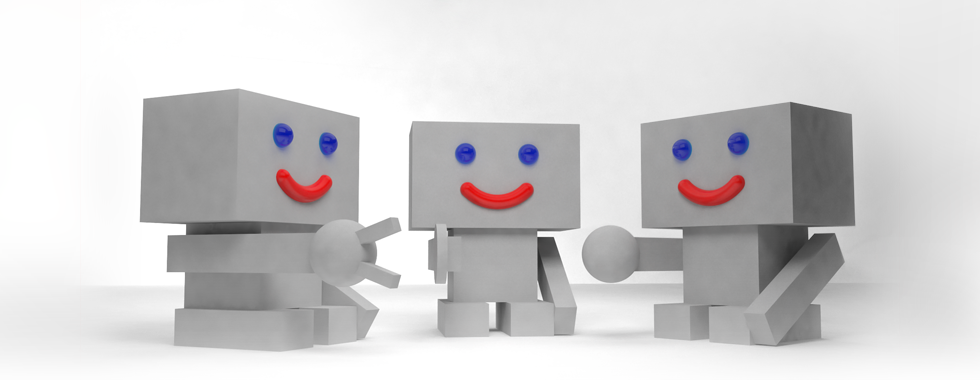Here you can see some of my programming projects, big and small.

Electric Potential Pong
March 2012
A pong game, made with Processing.js, containing 20 levels. The ball is influenced by the background electric potential, since the force on a charge is proportional to the gradient of the potential. The opponent is an AI implemented with PD control, whose gain increases with each increment in level. The background potential is generated randomly using a script written in MATLAB, so that the higher the level, the more complex it is. The game began out of boredom on a train ride home, and was finished the next day. Link to game »

MilkRunnr
January 2012
This is a web app that allows people to post their groceries online so that their neighbours may pick the items up for them. This was inspired by living in a dorm without a car, so buying groceries is really annoying. It would be so much better to just make your roommate go pick stuff up for you while he's doing his own groceries. MilkRunnr achieves this by letting users post a bounty for whoever buys the desired items for him.
The app is implemented with a backend on Ruby on Rails and a frontend with HTML5 and CSS3. We use Twitter Bootstrap 2 in the frontend, and have implemented some of our own styles using media query to enable better display and usability on mobile devices.
MilkRunnr was a finalist in the January 2012 entrepreneurship@UBC Hackathon for Berkeley’s University Mobile Challenge. I worked on the frontend coding and graphic design; the project is worked on by a team of five: Ricky Gu, Mustafa Fanaswala, Daniel Troniak, and Pouyan Taghipour.

RPSContest
June 2011
This website lets people submit Rock Paper Scissors algorithms, written in Python, to play against each other. Although rock-paper-scissors (RPS) may seem like a trivial game, it actually involves the hard computational problem of temporal pattern recognition. This problem is fundamental to the fields of machine learning, artificial intelligence, and data compression. In fact, it might even be essential to understanding how human intelligence works.
The app is implemented in Google App Engine with Python.
I worked on the frontend coding and graphic design. The project was created by a team of three, including Byron Knoll and Jonathan Burdge.
I have also submitted many algorithms to take part in the competition. In particular, one of my programs, called Centrifugal Bumblepuppy 4, won a tournament amongst the top ten entries on the leaderboard in August 16, 2011, with a win ratio of 78.1% (out of 9000 matches). The program uses an ensemble of many predictors to predict the opponent's playing style. See explanation of my algorithms »

Swinging Atwood's Machine
March 2011
The swinging Atwood's machine is a second order system exhibiting chaotic behaviour, quasiperiodicity, and some other cool things. I implemented a simulator in Processing for my Classical Mechanics class. The user can control the mass ratio, starting position, and starting velocity for the system. The program also calculates the so-called "zero velocity curve", which is an ellipse in which the swinging mass is always bounded. Using a variant of the Processing program, I have generated a video of the trajectories for different mass ratios. I have also contributed significantly to the Wikipedia article for the swinging Atwood's machine, and donated many pictures of trajectories to Wikimedia Commons. Processing applet »

The Sounds of Life
February 2011
This is a game developed for the Blackberry Playbook. It is a tone matrix that one can draw patterns to create music. While playing, the cellular automaton Conway's Game of Life is run on the pattern and an ever-evolving music plays. The player can adjust the pitch of each row, toggle the cellular automaton, and save the pattern as a string of characters that you can load in the future and play it back.
This game was created by a team of two: Jonathan Shen, and I. While Jonathan implemented the tone matrix, the cellular automaton, and the save capability, I ported it to Playbook and designed the graphics and audio engineering. Buy the app for Blackberry Playbook »

BML Traffic Model
December 2010
The Biham-Middleton-Levine traffic model is a simple 2D cellular automaton. The red cars and blue cars take turns to move downwards and leftwards respectively. Every time, all the cars of the same colour try to move one step if there is no car in front of it. I have written the Wikipedia article on the BML traffic model, and have donated many videos and pictures to Wikimedia Commons. In particular, my videos illustrating four different phases have been promoted to Featured Video status in English Wikipedia. Processing applet »
I am currently developing a new CUDA program to run the BML traffic model. Using a graphics card, it is ten times faster than my C++ program. So far, it has yielded some interesting results, which I will analyze in more detail in the near future.